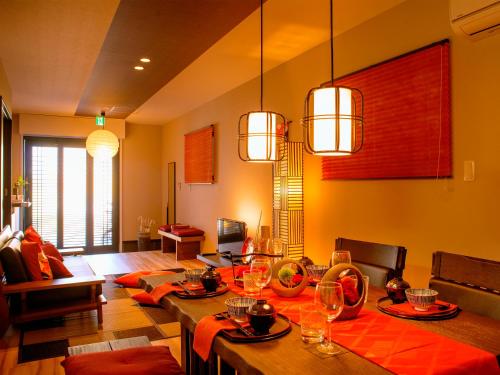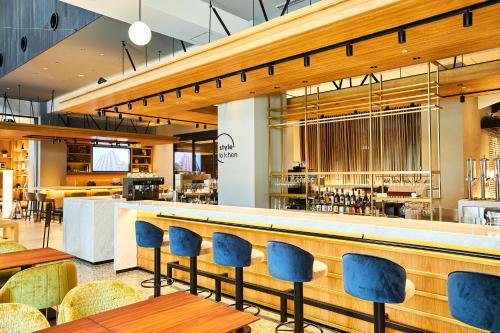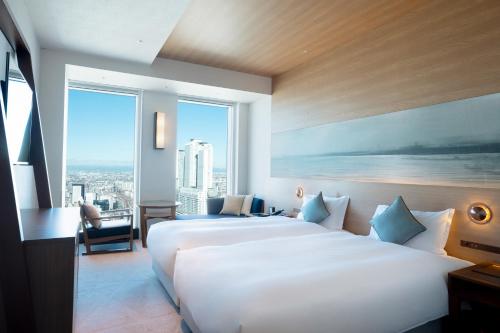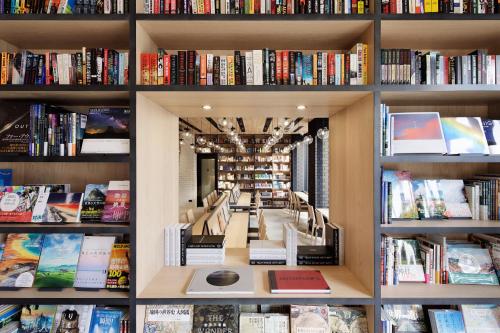Tokugawa Art Museum
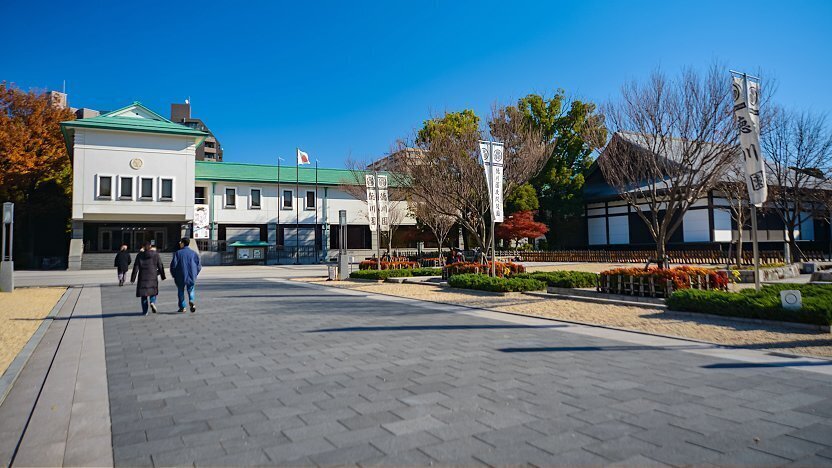
During the Edo Period (1603-1868), Nagoya served as the seat of the Owari, one of the three major branches of the ruling Tokugawa family. The family amassed great wealth that was only surpassed by four of the 200 feudal domains of the Edo Period. The Tokugawa Art Museum (ō┐Éņö³ÅpŖ┘, Tokugawa Bijutsukan) was built on the grounds of the Owari's former feudal residence and preserves and exhibits several of their treasures including samurai armor and swords, tea utensils, noh masks and costumes, poems, scrolls and maps.
Next to the museum is Tokugawa-en, a beautiful Japanese landscape garden with a large pond at its center. The garden used to be part of a retirement residence of the local lords, but was destroyed during the war. It was restored and reopened to the public in 2004. A large network of walking trails lead around the grounds to a tea house, rest houses, and across several bridges. The garden is best in spring, when its Peony (mid to late April) and Iris gardens (late May to early June) bloom, and during the autumn season (November).
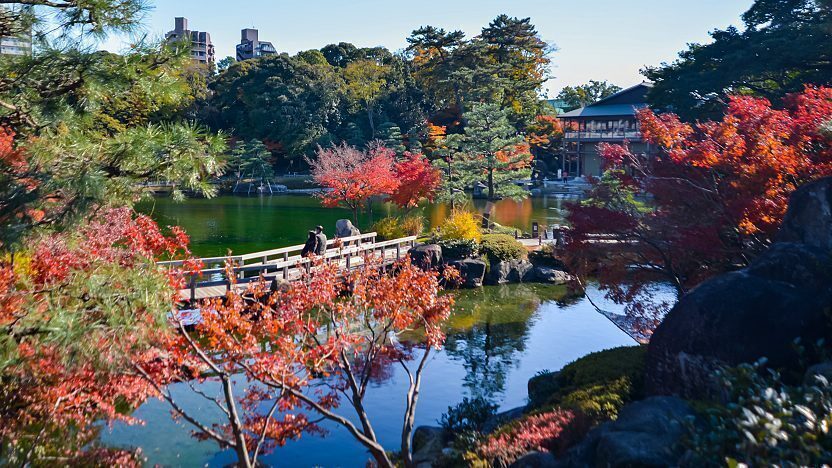
Getting there and around
The museum is a ten minute walk from Ozone Station on the JR Chuo Line, Meijo Subway Line and the Meitetsu Seto Line. Ozone Station is directly connected to Nagoya Station by the frequently operating JR Chuo Line (12 minutes, 210 yen one way).
Furthermore, the museum is also located along the Meguru loop bus line for tourists, and can be reached from Nagoya Station in about 35 minutes or from Nagoya Castle in about 15 minutes. The fare is 210 yen per ride or 500 yen for a day pass.
How to get to and around Nagoya

Hours and Fees
Tokugawa Art Museum
Hours
Closed
Admission
Tokugawa-en Garden
Hours
Closed
December 29 to January 1
Admission
Questions? Ask in our forum.
Links and Resources
Hotels around Nagoya
-
-
![]() Samurai HouseSituated in Nagoya, within 1.7 km of Nagoya Station and 4.2 km of Oasis 21, Samurai House features accommodation with free bikes and free WiFi throughout the property as well as free private parking for guests who drive. This 3-star hotel offers a 24-hour front desk and luggage storage space. The property is non-smoking and is located 4.7 km from Nagoya Castle. The rooms are fitted with air conditioning, a fridge, a microwave, a coffee machine, a bidet, free toiletries and a desk. Featuring a private bathroom with a shower and a hairdryer, rooms at the hotel also boast a city view. All guest rooms in Samurai House are fitted with a flat-screen TV and slippers. Aeon Mall Atsuta is 7.1 km from the accommodation, while Nippon Gaishi Hall is 12 km from the property. Nagoya Airport is 12 km away.View on Booking.com
Samurai HouseSituated in Nagoya, within 1.7 km of Nagoya Station and 4.2 km of Oasis 21, Samurai House features accommodation with free bikes and free WiFi throughout the property as well as free private parking for guests who drive. This 3-star hotel offers a 24-hour front desk and luggage storage space. The property is non-smoking and is located 4.7 km from Nagoya Castle. The rooms are fitted with air conditioning, a fridge, a microwave, a coffee machine, a bidet, free toiletries and a desk. Featuring a private bathroom with a shower and a hairdryer, rooms at the hotel also boast a city view. All guest rooms in Samurai House are fitted with a flat-screen TV and slippers. Aeon Mall Atsuta is 7.1 km from the accommodation, while Nippon Gaishi Hall is 12 km from the property. Nagoya Airport is 12 km away.View on Booking.com -
![]() The Tower Hotel NagoyaFeaturing a fitness centre, a restaurant as well as a bar, The Tower Hotel Nagoya is located in the centre of Nagoya, 200 metres from Oasis 21. This 5-star hotel offers a 24-hour front desk, a concierge service and free WiFi. Guests can have a drink at the snack bar. The hotel will provide guests with air-conditioned rooms with a wardrobe, a coffee machine, a fridge, a minibar, a safety deposit box, a flat-screen TV and a private bathroom with a bidet. Each room is equipped with a kettle, while some rooms are equipped with a terrace and others also offer garden views. Guests at The Tower Hotel Nagoya can enjoy an Asian breakfast. Nagoya Castle is 2.7 km from the accommodation, while Nagoya Station is 3 km away. Nagoya Airport is 10 km from the property.View on Booking.com
The Tower Hotel NagoyaFeaturing a fitness centre, a restaurant as well as a bar, The Tower Hotel Nagoya is located in the centre of Nagoya, 200 metres from Oasis 21. This 5-star hotel offers a 24-hour front desk, a concierge service and free WiFi. Guests can have a drink at the snack bar. The hotel will provide guests with air-conditioned rooms with a wardrobe, a coffee machine, a fridge, a minibar, a safety deposit box, a flat-screen TV and a private bathroom with a bidet. Each room is equipped with a kettle, while some rooms are equipped with a terrace and others also offer garden views. Guests at The Tower Hotel Nagoya can enjoy an Asian breakfast. Nagoya Castle is 2.7 km from the accommodation, while Nagoya Station is 3 km away. Nagoya Airport is 10 km from the property.View on Booking.com -
![]() Glocal Nagoya Backpackers HostelOpen from June 2015, Glocal Nagoya Backpackers Hostel offers modern accommodation, just a 7-minute walk from JR Nagoya Station. Guests can enjoy various beverages at the on-site bar or cafe. Free WiFi is available throughout the property. Guests can choose to stay in private rooms or in dormitory rooms. Dormitory rooms feature custom-made wooden bunk beds. Each bed has a plug and a small reading light by the head of the bed, and also privacy curtains. Bathroom facilities are shared with other guests. Shampoo and body soap are provided. There is a fully equipped shared kitchen and dining tables. Luggage storage, lockers and a coin launderette are also on offer at Nagoya Backpackers Hostel Glocal. English-speaking staff are readily available to help.View on Booking.com
Glocal Nagoya Backpackers HostelOpen from June 2015, Glocal Nagoya Backpackers Hostel offers modern accommodation, just a 7-minute walk from JR Nagoya Station. Guests can enjoy various beverages at the on-site bar or cafe. Free WiFi is available throughout the property. Guests can choose to stay in private rooms or in dormitory rooms. Dormitory rooms feature custom-made wooden bunk beds. Each bed has a plug and a small reading light by the head of the bed, and also privacy curtains. Bathroom facilities are shared with other guests. Shampoo and body soap are provided. There is a fully equipped shared kitchen and dining tables. Luggage storage, lockers and a coin launderette are also on offer at Nagoya Backpackers Hostel Glocal. English-speaking staff are readily available to help.View on Booking.com -
![]() GOLD STAY Nagoya Osu3.3 km from Nagoya Station, GOLD STAY Nagoya Osu features a recently renovated 3-star accommodation in the Naka Ward district of Nagoya. Among the facilities at this property are a lift and full-day security, along with free WiFi throughout the property. The aparthotel has family rooms. The aparthotel will provide guests with air-conditioned units with a wardrobe, a coffee machine, an oven, a microwave, a safety deposit box, a flat-screen TV and a private bathroom with a bidet. At the aparthotel, each unit is fitted with bed linen and towels. If you would rather not eat out, you can make use of the kitchenette facilities, which include a toaster, kettle and a fridge. Oasis 21 is 3.4 km from the aparthotel, while Aeon Mall Atsuta is 3.4 km from the property. Nagoya Airport is 13 km away.View on Booking.com
GOLD STAY Nagoya Osu3.3 km from Nagoya Station, GOLD STAY Nagoya Osu features a recently renovated 3-star accommodation in the Naka Ward district of Nagoya. Among the facilities at this property are a lift and full-day security, along with free WiFi throughout the property. The aparthotel has family rooms. The aparthotel will provide guests with air-conditioned units with a wardrobe, a coffee machine, an oven, a microwave, a safety deposit box, a flat-screen TV and a private bathroom with a bidet. At the aparthotel, each unit is fitted with bed linen and towels. If you would rather not eat out, you can make use of the kitchenette facilities, which include a toaster, kettle and a fridge. Oasis 21 is 3.4 km from the aparthotel, while Aeon Mall Atsuta is 3.4 km from the property. Nagoya Airport is 13 km away.View on Booking.com -
![]() TIAD, Autograph CollectionSet in Nagoya, less than 1 km from Oasis 21, TIAD, Autograph Collection offers accommodation with a terrace, private parking and a bar. Offering a restaurant, the property also has a fitness centre, as well as an indoor pool and a sauna. The accommodation features room service, a 24-hour front desk and currency exchange for guests. The hotel will provide guests with air-conditioned rooms with a wardrobe, a coffee machine, a fridge, a minibar, a safety deposit box, a flat-screen TV and a private bathroom with a bidet. All rooms are equipped with a kettle, while some rooms come with a balcony and others also have city views. Guests at TIAD, Autograph Collection can enjoy a buffet breakfast. The accommodation offers 5-star accommodation with a hot tub. Nagoya Station is 3.4 km from TIAD, Autograph Collection, while Nagoya Castle is 3.5 km away. Nagoya Airport is 11 km from the property.View on Booking.com
TIAD, Autograph CollectionSet in Nagoya, less than 1 km from Oasis 21, TIAD, Autograph Collection offers accommodation with a terrace, private parking and a bar. Offering a restaurant, the property also has a fitness centre, as well as an indoor pool and a sauna. The accommodation features room service, a 24-hour front desk and currency exchange for guests. The hotel will provide guests with air-conditioned rooms with a wardrobe, a coffee machine, a fridge, a minibar, a safety deposit box, a flat-screen TV and a private bathroom with a bidet. All rooms are equipped with a kettle, while some rooms come with a balcony and others also have city views. Guests at TIAD, Autograph Collection can enjoy a buffet breakfast. The accommodation offers 5-star accommodation with a hot tub. Nagoya Station is 3.4 km from TIAD, Autograph Collection, while Nagoya Castle is 3.5 km away. Nagoya Airport is 11 km from the property.View on Booking.com -
![]() Nikko Style NagoyaLocated in Nagoya, 1 km from Nagoya Station, Nikko Style Nagoya provides accommodation with a fitness centre, private parking, a restaurant and a bar. Located around 1.9 km from Oasis 21, the hotel with free WiFi is also 3.2 km away from Nagoya Castle. The accommodation features nightclub and a 24-hour front desk. The hotel will provide guests with air-conditioned rooms offering a desk, a kettle, a fridge, a safety deposit box, a flat-screen TV and a private bathroom with a bidet. Guest rooms include a wardrobe. Aeon Mall Atsuta is 5.4 km from Nikko Style Nagoya, while Nippon Gaishi Hall is 10 km away. Nagoya Airport is 12 km from the property.View on Booking.com
Nikko Style NagoyaLocated in Nagoya, 1 km from Nagoya Station, Nikko Style Nagoya provides accommodation with a fitness centre, private parking, a restaurant and a bar. Located around 1.9 km from Oasis 21, the hotel with free WiFi is also 3.2 km away from Nagoya Castle. The accommodation features nightclub and a 24-hour front desk. The hotel will provide guests with air-conditioned rooms offering a desk, a kettle, a fridge, a safety deposit box, a flat-screen TV and a private bathroom with a bidet. Guest rooms include a wardrobe. Aeon Mall Atsuta is 5.4 km from Nikko Style Nagoya, while Nippon Gaishi Hall is 10 km away. Nagoya Airport is 12 km from the property.View on Booking.com -
![]() Nagoya Prince Hotel Sky TowerLocated at 13-minute walk from Nagoya Station, Nagoya Prince Hotel Sky Tower offers free WiFi throughout the hotel. Shared parking is available on site for a fee. The 24 hour front desk offers free luggage storage service as well as concierge service for guests' convenience. This hotel features a fitness centre on site, while currency exchange service is offered at this property. There is a designated smoking area. Guests can relax with a massage service for a fee. All rooms have a TV, fridge and coffee machine. Guests will find nightwear and electric sockets near the bed. A closet is fitted in each room as well as a safety deposit box and iron. Private bathrooms are equipped with a bathrobe, hairdryer, and free toiletries. Extras include toothbrushes and slippers. Items for rent includes trouser press and DVD players. A bar and restaurant are available on site. Guests can find drinks at vending machine at this hotel. A variety of restaurants and cafes are accessible within a 10-minute walk from this hotel. Nagoya Castle is a 15-minute car ride away from Nagoya Prince Hotel Sky Tower. Nippon Gaishi Hall is 35 minutes by train. Chubu Airport is 45 minutes by train from this hotel.View on Booking.com
Nagoya Prince Hotel Sky TowerLocated at 13-minute walk from Nagoya Station, Nagoya Prince Hotel Sky Tower offers free WiFi throughout the hotel. Shared parking is available on site for a fee. The 24 hour front desk offers free luggage storage service as well as concierge service for guests' convenience. This hotel features a fitness centre on site, while currency exchange service is offered at this property. There is a designated smoking area. Guests can relax with a massage service for a fee. All rooms have a TV, fridge and coffee machine. Guests will find nightwear and electric sockets near the bed. A closet is fitted in each room as well as a safety deposit box and iron. Private bathrooms are equipped with a bathrobe, hairdryer, and free toiletries. Extras include toothbrushes and slippers. Items for rent includes trouser press and DVD players. A bar and restaurant are available on site. Guests can find drinks at vending machine at this hotel. A variety of restaurants and cafes are accessible within a 10-minute walk from this hotel. Nagoya Castle is a 15-minute car ride away from Nagoya Prince Hotel Sky Tower. Nippon Gaishi Hall is 35 minutes by train. Chubu Airport is 45 minutes by train from this hotel.View on Booking.com -
![]() LAMP LIGHT BOOKS HOTEL nagoyaOffering free WiFi, LAMP LIGHT BOOKS HOTEL nagoya is located a 3-minute walk from Exit 10 of Fushimi Subway Station. The property is 1.4 km from Oasis 21 and 1.8 km from Nagoya Castle. The ground floor features a 24-hour bookstore and cafe for guests to enjoy. All units are equipped with a flat-screen TV with satellite channels, a fridge, electric kettle, a high-tech toilet, free toiletries and a desk. The rooms include air conditioning, and some units at the economy hotel have a balcony. Each room features an armchair with a footrest. Private bathrooms feature a hairdryer, toothbrushes and free toiletries. There is a 24-hour front desk at the property. Coin-operated washing machines are available. Guests can enjoy breakfast at the on-site cafe or in their room. Nippon Gaishi Hall is 9 km from LAMP LIGHT BOOKS HOTEL nagoya, while Nagoya Congress Center is 4.2 km away. The nearest airport is Chubu Airport, 35 km from the accommodation.View on Booking.com
LAMP LIGHT BOOKS HOTEL nagoyaOffering free WiFi, LAMP LIGHT BOOKS HOTEL nagoya is located a 3-minute walk from Exit 10 of Fushimi Subway Station. The property is 1.4 km from Oasis 21 and 1.8 km from Nagoya Castle. The ground floor features a 24-hour bookstore and cafe for guests to enjoy. All units are equipped with a flat-screen TV with satellite channels, a fridge, electric kettle, a high-tech toilet, free toiletries and a desk. The rooms include air conditioning, and some units at the economy hotel have a balcony. Each room features an armchair with a footrest. Private bathrooms feature a hairdryer, toothbrushes and free toiletries. There is a 24-hour front desk at the property. Coin-operated washing machines are available. Guests can enjoy breakfast at the on-site cafe or in their room. Nippon Gaishi Hall is 9 km from LAMP LIGHT BOOKS HOTEL nagoya, while Nagoya Congress Center is 4.2 km away. The nearest airport is Chubu Airport, 35 km from the accommodation.View on Booking.com -
![]() Nagoya Kanko HotelEstablished in 1936, Nagoya Kanko Hotel is located in the downtown area of Sakae and offers rooms with free wired internet, a fitness centre and a beauty salon. It features 5 restaurants, free WiFi and free parking. From breakfast to bar time, the exclusive Club Floor lounge offers a wide range of dishes by our chefs using local ingredients, as well as sake and wine made at local breweries, all under the theme of üglocal production for local consumptionüh Guests at Hotel Kanko Nagoya can relax with a massage treatment, or browse in the hotelüfs shopping arcade. Services include a concierge and in-room dining. The hotel features international buffet dining, as well as Japanese and Chinese cuisine. Brasserie & Cafe Le Sud offers fresh pastries, while French restaurant Escoffier boasts over 200 fine wines. Nagoya Kanko Hotel is a 2-minute walk from Fushimi Subway Station and a 10-minute walk from Nagoya City Art Museum. Nagoya Castle is an 8-minute drive away.View on Booking.com
Nagoya Kanko HotelEstablished in 1936, Nagoya Kanko Hotel is located in the downtown area of Sakae and offers rooms with free wired internet, a fitness centre and a beauty salon. It features 5 restaurants, free WiFi and free parking. From breakfast to bar time, the exclusive Club Floor lounge offers a wide range of dishes by our chefs using local ingredients, as well as sake and wine made at local breweries, all under the theme of üglocal production for local consumptionüh Guests at Hotel Kanko Nagoya can relax with a massage treatment, or browse in the hotelüfs shopping arcade. Services include a concierge and in-room dining. The hotel features international buffet dining, as well as Japanese and Chinese cuisine. Brasserie & Cafe Le Sud offers fresh pastries, while French restaurant Escoffier boasts over 200 fine wines. Nagoya Kanko Hotel is a 2-minute walk from Fushimi Subway Station and a 10-minute walk from Nagoya City Art Museum. Nagoya Castle is an 8-minute drive away.View on Booking.com -
![]() The Royal Park Hotel Iconic NagoyaConveniently located in the centre of Nagoya, The Royal Park Hotel Iconic Nagoya offers air-conditioned rooms, a fitness centre, free WiFi and a restaurant. This 4-star hotel offers a bar. The hotel has a sauna and a 24-hour front desk. At the hotel, all rooms have a wardrobe. With a private bathroom fitted with a bidet and free toiletries, rooms at The Royal Park Hotel Iconic Nagoya also have a city view. All guest rooms in the accommodation are equipped with a flat-screen TV and a hairdryer. A buffet breakfast is available at The Royal Park Hotel Iconic Nagoya. Oasis 21 is 600 metres from the hotel, while Nagoya Castle is 2.9 km from the property. Nagoya Airport is 10 km away.View on Booking.com
The Royal Park Hotel Iconic NagoyaConveniently located in the centre of Nagoya, The Royal Park Hotel Iconic Nagoya offers air-conditioned rooms, a fitness centre, free WiFi and a restaurant. This 4-star hotel offers a bar. The hotel has a sauna and a 24-hour front desk. At the hotel, all rooms have a wardrobe. With a private bathroom fitted with a bidet and free toiletries, rooms at The Royal Park Hotel Iconic Nagoya also have a city view. All guest rooms in the accommodation are equipped with a flat-screen TV and a hairdryer. A buffet breakfast is available at The Royal Park Hotel Iconic Nagoya. Oasis 21 is 600 metres from the hotel, while Nagoya Castle is 2.9 km from the property. Nagoya Airport is 10 km away.View on Booking.com
-
Experiences around Nagoya
-
-
![]() SponsoredEnjoy Siphon-Brewed Tea and Admire Bonsai at a Siphon Specialty Shop in NagoyaOwned by award-winning siphonist Yoshinobu Nakayama, Saihon no Ma is a shop in Nagoya that specializes in siphon-brewed coffee and tea. Here, learn to brew tea with a device called a siphon, which was invented in Europe. Now relatively obscure in many other countries, siphon brewing remains popular in Japan, resulting in the development of uniquely Japanese brewing techniques. Enjoy fragrant and flavorful Japanese tea while admiring the bonsai displays that adorn the shop.View experienceSponsored
SponsoredEnjoy Siphon-Brewed Tea and Admire Bonsai at a Siphon Specialty Shop in NagoyaOwned by award-winning siphonist Yoshinobu Nakayama, Saihon no Ma is a shop in Nagoya that specializes in siphon-brewed coffee and tea. Here, learn to brew tea with a device called a siphon, which was invented in Europe. Now relatively obscure in many other countries, siphon brewing remains popular in Japan, resulting in the development of uniquely Japanese brewing techniques. Enjoy fragrant and flavorful Japanese tea while admiring the bonsai displays that adorn the shop.View experienceSponsored
-

